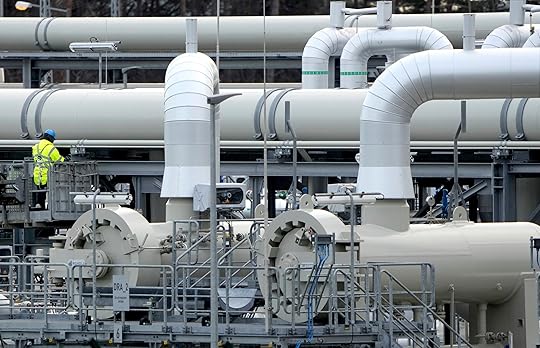Steve Bull's Blog, page 217
June 20, 2022
Germany Rations Gas Amid Russian Cuts, Mandates Return To Coal For Electricity Production
German Vice Chancellor and Economy Minister Robert Habeck said Sunday that the country will limit the use of natural gas for electricity production amid concerns about possible shortages caused by a cut in supplies from Russia.
As a member of the environmentalist Green Party, Habeck pushed through legislation in April to raise Germany’s energy target to 80% renewables. He is also an opponent of nuclear energy.
Habeck said that Germany will try to compensate for the move by increasing the burning of coal, a more polluting fossil fuel.
“That’s bitter, but it’s simply necessary in this situation to lower gas usage,”
The decision comes just days after Russian gas company Gazprom announced that it was sharply reducing supplies through the Nord Stream 1 pipeline for technical reasons, but which Habeck said appeared to be politically motivated.
“It’s obvious that (Russian President Vladimir) Putin’s strategy is to unsettle us by driving up the price and dividing us,” Habeck said.
“We won’t let that happen.”
Habeck’s Press Release on Reducing Natural Gas Consumption.
Gas Reduction in Electricity Sector
“The situation on the gas market has deteriorated in recent days. The missing quantities can still be replaced, and the gas storage tanks are still being filled, albeit at high prices. Security of supply is currently guaranteed. But the situation is serious. We are therefore further strengthening precautions and taking additional measures to reduce gas consumption. This means that gas consumption must continue to fall, so more gas must be stored in storage, otherwise things will get really tight in winter. We will now take the next steps…
…click on the above link to read the rest of the article…
Starving Sri Lanka Shortens Work Week to Give People Time to Grow Food
 Buddhika Weerasinghe/Bloomberg via Getty Images
Buddhika Weerasinghe/Bloomberg via Getty ImagesSri Lanka’s federal government on Monday approved a proposal that would shorten the work week of most public sector staff to four days so that workers will have time to farm their own crops, Reuters reported Tuesday, noting the measure aims to combat Sri Lanka’s worsening food shortages caused by a recent economic crisis.
“Sri Lanka’s Cabinet late on Monday approved a proposal for public sector workers to be given leave every Friday for the next three months, partly because the fuel shortage made commuting difficult and also to encourage them to farm,” Reuters reported on June 14.
“It seems appropriate to grant government officials leave of one working day … to engage in agricultural activities in their backyards or elsewhere as a solution to the food shortage that is expected,” the Sri Lankan government information office said in a statement.
The shortened work week will not apply to public sector employees in “essential” fields, such as health or education, Sri Lanka Cabinet Minister Dinesh Gunawardana said on June 13.
In addition to the four-day work week, Sri Lanka’s federal government approved a program on Monday in which “public servants can apply for five year no pay leave to go abroad for employment opportunities [sic],” Sri Lanka’s Daily Mirror reported on June 14.
“It will not affect their promotions or retirement upon return,” the newspaper said of the work-abroad initiative.
Sri Lanka’s public sector employs roughly one million people, according to Reuters.
The Sri Lankan federal government was forced to give most public sector staff an unplanned day off on June 13 after realizing that worsening power outages and fuel shortages nationwide would make it nearly impossible for the employees to travel to work or conduct business as usual.
…click on the above link to read the rest of the article…
Our Economy In a Nutshell
The economy has reached an inflection point where everything that is unsustainable finally starts unraveling.
Our economy is in a crisis that’s been brewing for decades. The Chinese characters for the English word crisis are famously–and incorrectly–translated as danger and opportunity. The more accurate translation is precarious plus critical juncture or inflection point.
Beneath its surface stability, our economy is precarious because the foundation of the global economy– cheap energy–has reached an inflection point: from now on, energy will become more expensive.
The cost will be too low for energy producers to make enough money to invest in future energy production, and too high for consumers to have enough money left after paying for the essentials of energy, food, shelter, etc., to spend freely.
For the hundred years that resources were cheap and abundant, we could waste everything and call it growth: when an appliance went to the landfill because it was designed to fail (planned obsolescence) so a new one would have to be purchased, that waste was called growth because the Gross Domestic Product (GDP) went up when the replacement was purchased.
A million vehicles idling in a traffic jam was also called growth because more gasoline was consumed, even though the gasoline was wasted.
This is why the global economy is a “waste is growth” Landfill Economy. The faster something ends up in the landfill, the higher the growth.
Now that we’ve consumed all the easy-to-get resources, all that’s left is hard to get and expensive. For example, minerals buried in mountains hundreds of miles from paved roads and harbors require enormous investments in infrastructure just to reach the deposits, extract, process and ship them to distant mills and refineries. Oil deposits that are deep beneath the ocean floor are not cheap to get.
…click on the above link to read the rest of the article…
Oops! U.S. oil and gas exports fuel domestic price rise
The real reason behind the push was that the oil and gas industry wanted what almost every other industry in American already had: The right to sell their products to the highest bidders no matter where they lived on the globe.
This made it almost certain that as U.S. prices rose to match world prices, U.S. consumers would feel the pain. And, since energy prices affect everyone who votes, they are always politically consequential.
So, it is unsurprising that with U.S. regular gasoline prices over $5 per gallon President Joe Biden lashed out at U.S. oil companies—which are having one of their best years ever—saying they need to increase production of refined oil products. The companies have responded that their refineries are running at close to maximum capacity and so there is not much they can do in the short run.
What is left unsaid is that it has long been the policy of the United States to allow the export of refined (as opposed to crude) petroleum products such as gasoline, diesel and heating oil. The country has refinery capacity significantly in excess of domestic needs and so exports a considerable volume of refined products including about 1 million barrels per day (mbpd) of gasoline and 1.4 mbpd of diesel and heating oil (for the week ending June 10)…
…click on the above link to read the rest of the article…
Did Europe’s Latest (& Little Noticed) Anti-Russia Move Just Push The World Closer To WW3?
Quite possibly the biggest Russia-West provocation of the entire four-month long war in Ukraine has occurred this weekend, but few in the media establishment seem to be taking notice of the singular event which has the potential to quickly spiral toward a WW3 scenario.
Baltic EU/NATO member Lithuania has implemented a ban on all rail transit goods going to Russia’s far-western exclave of Kaliningrad, after transport authorities initially announced the provocative measure on Friday. “The EU sanctions list notably includes coal, metals, construction materials and advanced technology, and Alikhanov said the ban would cover around 50% of the items that Kaliningrad imports,” Reuters wrote.
This has given way to fears of panic buying breaking out in Kaliningrad Oblast, which is Russian sovereign territory on the Baltic Sea, but which is sandwiched between Lithuania and Poland, and is thus reliant on overland shipping for passage via its EU neighbors.
Anton Alikhanov, the governor of the Russian oblast which has a total population of some one million people (with Kaliningrad city including almost 450,000 – and 800,000 total if outlying suburbs are counted) is urging calm:
Urging citizens not to resort to panic buying, Alikhanov said two vessels were already ferrying goods between Kaliningrad and Saint Petersburg, and seven more would be in service by the end of the year.
“Our ferries will handle all the cargo”, he said on Saturday.
Russian officials and media have long warned against what they dubbed Western aims to “blockade” Kaliningrad. Crucially, the EU enforcement measure being implemented from Vilnius marks a complete break in a three decade long treaty that’s been in effect…
…click on the above link to read the rest of the article…
June 18, 2022
The Engineered Stagflationary Collapse Has Arrived – Here’s What Happens Next

In my 16 years as an alternative economist and political writer I have spent around half that time warning that the ultimate outcome of the Federal Reserve’s stimulus model would be a stagflationary collapse. Not a deflationary collapse, or an inflationary collapse, but a stagflationary collapse. The reasons for this were very specific – Mass debt creation was being countered with MORE debt creation while many central banks have been simultaneously devaluing their currencies through QE measures. On top of that, the US is in the unique position of relying on the world reserve status of the dollar and that status is diminishing.
It was only a matter of time before the to forces of deflation and inflation met in the middle to create stagflation. In my article ‘Infrastructure Bills Do Not Lead To Recovery, Only Increased Federal Control’, published in April of 2021, I stated that:
“Production of fiat money is not the same as real production within the economy… Trillions of dollars in public works programs might create more jobs, but it will also inflate prices as the dollar goes into decline. So, unless wages are adjusted constantly according to price increases, people will have jobs, but still won’t be able to afford a comfortable standard of living. This leads to stagflation, in which prices continue to rise while wages and consumption stagnate.
Another Catch-22 to consider is that if inflation becomes rampant, the Federal Reserve may be compelled (or claim they are compelled) to raise interest rates significantly in a short span of time. This means an immediate slowdown in the flow of overnight loans to major banks, an immediate slowdown in loans to large and small businesses, an immediate crash in credit options for consumers, and an overall crash in consumer spending…
…click on the above link to read the rest of the article…
June 17, 2022
Media: Why the Fed Raised 75 bps and How to Break the Davos Crowd

I sat down for a long chat with my good friend Crypto Rich over the weekend and have just found the 20 minutes to post them here. We did a series of videos, Duran-style, on a number of topics. They are all below.
With the Fed raising by 75 bps yesterday I have to believe we’ve reached a major turning point in the War Against Davos. The deflation of asset prices and, most especially the Eurodollar markets is putting many other, over-leveraged central banks on a path towards bankruptcy.
There are a ton of moving parts, a lot of factions now warring against each other. When cartels break, the former members of the cartel always turn on each other. It was always going to be this way. Davos turned on its allies in the US commercial banking sector and they fought back.
Hard.
Everything I wrote about in my last post — SOFR/LIBOR spreads, US/German 10 year Spreads, Lagarde’s incompetence — were proven correct in the response yesterday by the markets to Powell’s hawkishness.
Davos has spent so long and so much money trying to convince us to ‘abandon all hope’ but it is they who now can do nothing but ‘enter here’ into our dragon’s den of asset deflation. The adjustment will be biblical. It will be painful.
And it didn’t have to be this way, but the solipsism and arrogance of evil people who have always known power and feel entitled to wield it in perpetuity is boundless.
Enjoy the rants and the wailing and gnashing of teeth by the very worst people in the world today.
The links below are to the videos on Odysee
 Part 1 of the main talkPart 2 of the main talkHow to Break the Great Reset
Part 1 of the main talkPart 2 of the main talkHow to Break the Great Reset
Australia’s Energy Crisis Worsens As Gov’t Ask People To Keep Lights Off To Avert Blackouts
Australia’s energy minister asked Sydney and the New South Wales (eastern part of the country) residents to turn off lights and energy-intensive appliances in the evening to prevent power blackouts due to an ongoing energy crunch, The Independent reports.
The federal energy minister, Chris Bowen, asked residents in a televised address to turn off energy-intensive devices between “6 to 8 [pm]” to mitigate risks of a spike in power during peak hours. He pointed to several offline coal-fired plants because of maintenance and unexpected issues.
Reuters notes that 65% of eastern Australia’s power is generated by coal, but more than a quarter of that capacity is offline.
Wholesale electricity prices have soared and on Monday exceeded the capped price of A$300 per megawatt-hour. Above A$300, coal power generation plants lost money and forced some operators to shutter power generation units, thus removing energy capacity off the grid and sending prices even higher. The rise of power prices began when coal prices jumped following the Russian invasion of Ukraine.
Bowen snapped at a journalist when asked if more coal power is the answer the energy crunch.
“The situation in recent days has posed challenges to the entire energy industry, and suspending the market would simplify operations during the significant outages across the energy supply chain,” Australian Energy Market Operator (AEMO) chief executive Daniel Westerman said in a statement.
“It was understandable generators had held back supply in light of the price caps along with unplanned outages and supply challenges with coal and gas , but having to direct generators to provide supply had made it impossible to maintain normal market operations,” Westerman said.
…click on the above link to read the rest of the article…
Oil markets are pricing in long-term supply deficits and OPEC+ will face historic lows in spare capacity, warns IEA
 IEA Executive Director Fatih Birol. Anadolu Agency/Getty ImagesThe IEA issued a warning for global oil markets Wednesday, saying supply challenges will persist.Three million barrels per day of Russian crude will disappear as sanctions set in, the IEA predicts.“Severely restricted refining capacity is causing markets to price in long-term supply deficits in key refined products,” the report said.
IEA Executive Director Fatih Birol. Anadolu Agency/Getty ImagesThe IEA issued a warning for global oil markets Wednesday, saying supply challenges will persist.Three million barrels per day of Russian crude will disappear as sanctions set in, the IEA predicts.“Severely restricted refining capacity is causing markets to price in long-term supply deficits in key refined products,” the report said.The current turmoil across energy markets is set to worsen in 2023, as OPEC+ will face severe supply challenges while fuel prices will stay high, the International Energy Agency warned in its first forecast for next year.
The Paris-based think tank said Wednesday that global oil supplies will “struggle” to keep up with rising demand.
In particular, it highlighted that Russian barrels will disappear from this year’s market at a rate of 3 million barrels per day as more sanctions set in. That result in overall OPEC+ production falling by 520,000 barrels per day next year.
“OPEC+ would have to further tap into its dwindling capacity cushion, reducing it to historic lows,” the IEA said in its report.
Over recent months, oil prices have skyrocketed thanks to dwindling stockpiles and repercussions from Russia’s invasion of Ukraine. In March, the price of Brent crude briefly hit $139 a barrel. It’s hovering near $120 Wednesday.
US gas prices, too, have surged, recently breaking the $5-a-gallon threshold for the first time ever. And the IEA warned prices will stay high for a while as refineries live “hand-to-mouth” amid low crude and product inventories.
“Severely restricted refining capacity is causing markets to price in long-term supply deficits in key refined products,” the agency said. “This translates into a structurally elevated product price outlook.”
…click on the above link to read the rest of the article…
Winter is coming: German agency head warns of gas shortages, bankruptcies, and massive price hikes that will send ‘shockwaves throughout the country’
Inflation is already taking its toll on the German economy, but next winter is now being described in near apocalyptic terms by one prominent German agency head

A gas shortage and high prices will send “shockwaves through the country,” leading to landlords cutting the heat for tenants and widespread company bankruptcies, warned Klaus Müller, the head of Germany’s Federal Network Agency, which is the regulatory office for electricity, gas, telecommunications, postal services, and railway markets.
Müller paints a bleak picture about the crisis in an interview with German newspaper Rheinische Post, saying it will “send shockwaves throughout the country. Banks will ramp up their business with installment loans, and ailing companies will fall into insolvency.”
Müller’s office, which is a federal agency within the Federal Ministry for Economic Affairs and Climate Action, has a bird’s eye view of the economic situation in Germany and also special insight into how economic conditions will develop into the future.

As Germany prepares for crisis, one German energy expert is warning of a situation “where markets simply stop functioning”
Müller says he expects gas prices to continue to climb, resulting in increased inflation that goes far beyond energy. He also warns that there will be a dramatic lack of gas in the winter, which could lead to landlords turning down the heat to save on energy. In turn, Germans may have to grapple with colder apartments.
In a sign that the German government is operating under the assumption that a potential crisis could develop in winter, there are already talks about potentially lowering heating requirement for landlords.
…click on the above link to read the rest of the article…





